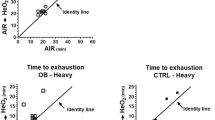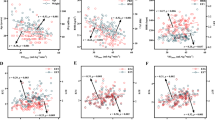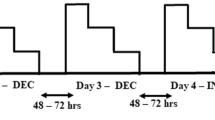Abstract
Objective:
To compare the phase II oxygen uptake time constant (τV′O2) and V′O2 mean response time (V′O2MRT) in overweight (OW) and non-OW (NO) children during moderate intensity exercise.
Design:
Between subjects where participants completed a maximal ramp exercise test on an electromagnetically braked cycle ergometer to determine peak V′O2 (V′O2peak) and gas exchange threshold (GET). Gas exchange was measured breath-by-breath using a mass spectrometer. On subsequent visits, 6 square-wave transitions (⩽2 per day) from 0 W to 90% GET were completed. Individual phase II τV′O2 and V′O2MRTs were estimated from time aligned average V′O2 traces.
Subjects:
Eleven OW (11.8±0.4 years) and 12 NO (11.9±0.4 years) children were recruited to the study. The OW group was significantly heavier (62.9±9.7 vs 39.4±5.8 kg, P<0.001), taller (1.58±0.05 vs 1.47±0.07 m, P<0.001) and had a higher body mass index (25.8±3.4 vs 18.3±1.8 kg m−2, P<0.001).
Results:
Both τV′O2 (30.2±9.6 vs 22.8±7.1 s, P<0.05) and V′O2MRT (43.5±10.7 vs 36.3±5.3 s, P<0.05) were significantly slower in OW compared with NO children; absolute V′O2peak was higher in the OW compared with NO group (2.23±0.04 vs 1.74±0.04 l min−1, P<0.05); mass relative V′O2peak was lower in OW compared with NO children (35.9±8.3 vs 43.8±6.2 ml kg−1 min−1, P<0.05); allometrically scaled V′O2peak was similar between OW and NO groups whether relative to body mass0.67 (139.8±29.1 vs 147.2±23.9 ml kg−67 min−1) or stature3 (576.0±87.2 vs 544.9±84.9 ml m−3 min−1) (P>0.05); absolute V′O2 at GET was similar between OW and NO groups (0.94±0.24 vs 0.78±0.27 l min−1, P>0.05); GET expressed as percentage of V′O2peak was similar between the groups (42.0±0.1 vs 44.8±0.1%, P>0.05).
Conclusion:
These findings demonstrate impairment in the factors determining V′O2 kinetics in OW children at a relatively young age. Furthermore, assessment of cardiorespiratory fitness using peak exercise values is likely to be misleading and not useful when designing exercise programmes for OW children.
This is a preview of subscription content, access via your institution
Access options
Subscribe to this journal
Receive 12 print issues and online access
$259.00 per year
only $21.58 per issue
Buy this article
- Purchase on Springer Link
- Instant access to full article PDF
Prices may be subject to local taxes which are calculated during checkout


Similar content being viewed by others
References
Ebbelling CB, Pawlak DB, Ludwig DS . Childhood obesity: public health crisis common sense cure. Lancet 2002; 360: 473–482.
Owens S, Gutin B, Allison J, Riggs S, Ferguson M, Litaker M et al. Effect of physical training on total and visceral fat in obese children. Med Sci Sports Exerc 1999; 31: 143–148.
Bell LM, Byrne S, Thompson A, Ratnam N, Blair E, Bulsara M et al. Increasing body mass index z-scores is continuously associated with complications of overweight in children, even in the healthy weight range. J Clin Endcrinol Metabol 2007; 92: 517–522.
Drinkard B, McDuffie J, McCann S, Uwaifo GI, Nicholson J, Yanovski JA . Relationships between walk/run performance and cardiorespiratory fitness in adolescents who are overweight. Phys Ther 2001; 81: 1889–1896.
Goran M, Fields DA, Hunter GR, Herd SL, Weinsier RL . Total body fat does not influence maximal aerobic capacity. Int J Obes Relat Metabol Dis 2000; 24: 841–848.
Rowland TW, Bhargava R, Parslow D, Heptulla RA . Cardiac response to progressive cycle exercise in moderately obese adolescent females. J Adolesc Health 2003; 32: 422–427.
Armstrong N . Young people’s physical activity patterns as assessed by heart rate monitoring. J Sports Sci 1998; 16: S9–S16.
Whipp BJ . The slow component of O2 uptake kinetics during heavy exercise. Med Sci Sports Exerc 1994; 26: 1319–1326.
Markovitz GH, Sayre JW, Storer TW, Cooper CB . On issues of confidence in determining the time constant for oxygen uptake kinetics. Br J Sports Med 2004; 38: 553–560.
Barstow TJ, Buchthal S, Zanconato S, Cooper DM . Muscle energetics and pulmonary oxygen uptake kinetics during moderate exercise. J Appl Physiol 1994; 77: 1742–1749.
Whipp BJ, Davis JA, Torres F, Wasserman K . A test to determine parameters of aerobic function during exercise. J Appl Physiol 1981; 50: 217–221.
Armstrong N, Welsman J . Young People and Physical Activity. Oxford University Press: Oxford, UK, 1997.
Eriksson BO, Gollnick PD, Saltin B . Muscle metabolism and enzyme activities after training in boys 11-13 years old. Acta Physiol Scand 1973; 87: 485–497.
Haralambie G . Enzyme activities in skeletal muscle of 13-15 years old adolescents. Bull Eur Physiopathologie Respir 1982; 18: 65–74.
Cooper DM, Poage J, Barstow TJ, Springer C . Are obese children truly unfit? Minimizing the confounding effect of body size on the exercise response. J Pediatr 1990; 116: 223–230.
Loftin M, Heusel L, Bonis M, Carlisle L, Sothern M . Comparison of oxygen uptake kinetics and oxygen deficit in severely overweight and normal weight adolescent females. J Sport Sci Med 2005; 4: 430–436.
Unnithan VB, Baynard T, Potter CR, Barker P, Heffernan KS, Kelly E et al. An exploratory study of cardiac function and oxygen uptake during cycle ergometry in overweight children. Obesity 2007; 15: 2673–2682.
Salvadego D, Lazzer S, Busti C, Galli R, Agosti F, Lafortuna C et al. Gas exchange kinetics in obese adolescents. Inferences on exercise tolerance and prescription. Am J Physiol Regul Integr Comp Physiol 2010; 299: R1298–R1305.
Potter CR, Childs DJ, Houghton W, Armstrong N . Breath-to-breath "noise" in the ventilatory and gas exchange responses of children to exercise. Eur J Appl Physiol 1999; 80: 118–124.
Cole T, Bellizzi M, Flegal K, Dietz W . Establishing a standard definition for child overweight and obesity worldwide: International survey. Br Med J 2000; 320: 1240–1243.
Beaver WL, Wasserman K, Whipp BJ . A new method for detecting anaerobic threshold by gas exchange. J Appl Physiol 1986; 60: 2020–2027.
Mettauer B, Zhao Q, Epailly E, Charloux A, Lampert E, Heitz-Naegelen B et al. V′O2 kinetics reveal a central limitation at the onset of subthreshold exercise in heart transplant recipients. J Appl Physiol 2000; 88: 1228–1238.
Fawkner SG, Armstrong N, Potter CR, Welsman JR . Oxygen uptake kinetics in children and adults after the onset of moderate-intensity exercise. J Sports Sci 2002; 20: 319–326.
Whipp BJ, Ward SA, Lamarra N, Davis JA, Wasserman K . Parameters of ventilatory and gas exchange dynamics during exercise. J Appl Physiol 1982; 52: 1506–1513.
Brandenburg SL, Reusch JE, Bauer TA, Jeffers BW, Hiatt WR, Regensteiner JG . Effects of exercise training on oxygen uptake kinetic responses in women with type 2 diabetes. Diabetes Care 1999; 22: 1640–1646.
Reybrouck T, Vinckx J, Gewillig M . Assessment of oxygen deficit during exercise in obese children and adolescents. Pediatr Exerc Sci 2005; 17: 291–300.
Whipp BJ . Dynamics of pulmonary gas exchange. Circulation 1987; 76: S18–S28.
Hughson RL . Exploring cardiorespiratory control mechanisms through gas exchange dynamics. Med Sci Sports Exerc 1990; 22: 72–79.
Whipp BJ, Mahler M . Dynamics of pulmonary gas exchange during exercise. In: West JB, (eds) Pulmonary Gas Exchange, vol. II, Organism and Environment. Academic Press: New York, NY, 1980. pp 33–96.
Huttunen N, Knip M, Paavilainen T . Physical activity and fitness in obese children. Int J Obes 1986; 10: 519–525.
Pate RR, Wang CY, Dowda M, Farrell SW, O’Neill JR . Cardiorespiratory fitness levels among US youth 12 to 19 years of age: findings from the 1999–2002 National Health and Nutrition Examination Survey. Arch Pediatr Adolesc Med 2006; 160: 1005–1012.
Grund A, Dilba B, Forberger K, Krause H, Siewers M, Rieckert H et al. Relationships between physical activity, physical fitness, muscle strength and nutritional state in 5- to 11-year-old children. Eur J Appl Physiol 2000; 82: 425–438.
Bar-Or O . Pediatric Sports Medicine for the Practitioner: from Physiologic Principles to Clinical Applications. Springer-Verlag: New York, NY, 1983.
Reybrouck T, Deroost F, Van der Hauwaert L . Evaluation of breath-by-breath measurement of respiratory gas exchange in pediatric exercise testing. Chest 1992; 102: 147–152.
Rowland TW . Children’s Exercise Physiology. Human Kinetics: Champaign, IL, 2005.
Motulsky HJ, Ransnas LA . Fitting curves to data using nonlinear regression: a practical and nonmathmatical review. J Federation Am Societies Exp Biol 1987; 1: 365–374.
Jebb SA, Prentice AM . Single definition of overweight and obesity should be used. Br Med J 2001; 32: 999.
Mei Z, Grummer-Strawn LM, Pietrobelli A, Goulding A, Goran MI, Dietz WH . Validity of body mass index compared with other body-composition screening indexes for the assessment of body fatness in children and adolescents. Am J Clin Nutr 2002; 75: 978–985.
Daniels SR . The use of BMI in the clinical setting. Pediatrics 2009; 124: S35–S41.
Krebs NF, Himes JH, Jacobson D, Nicklas TA, Guilday P, Styne D . Assessment of Child and Adolescent Overweight and Obesity. Pediatrics 2007; 120: S193–S228.
Acknowledgements
This work was supported by a research studentship from the University of Gloucestershire. We wish to thank Matthew Black and Thomas Davenport for their assistance with data collection.
Author information
Authors and Affiliations
Corresponding author
Ethics declarations
Competing interests
The authors declare no conflict of interest.
Rights and permissions
About this article
Cite this article
Potter, C., Zakrzewski, J., Draper, S. et al. The oxygen uptake kinetic response to moderate intensity exercise in overweight and non-overweight children. Int J Obes 37, 101–106 (2013). https://doi.org/10.1038/ijo.2012.130
Received:
Revised:
Accepted:
Published:
Issue Date:
DOI: https://doi.org/10.1038/ijo.2012.130
Keywords
This article is cited by
-
The influence of body weight on the pulmonary oxygen uptake kinetics in pre-pubertal children during moderate- and heavy intensity treadmill exercise
European Journal of Applied Physiology (2013)



